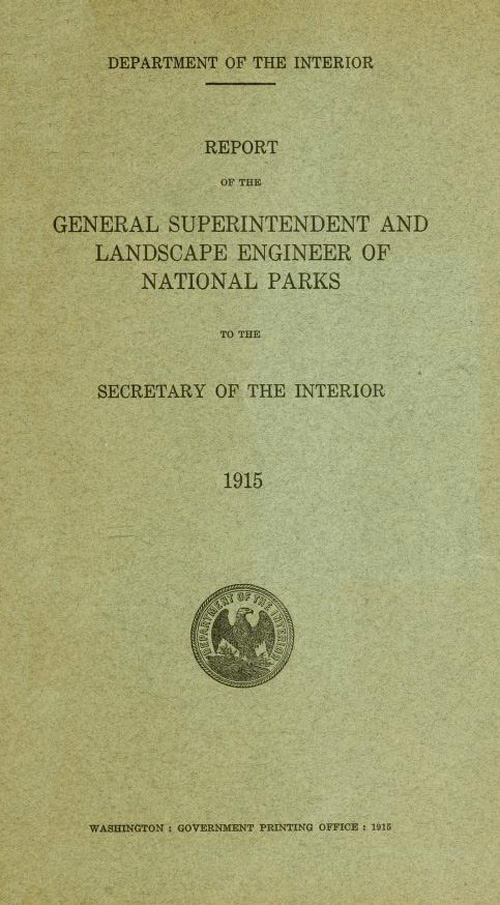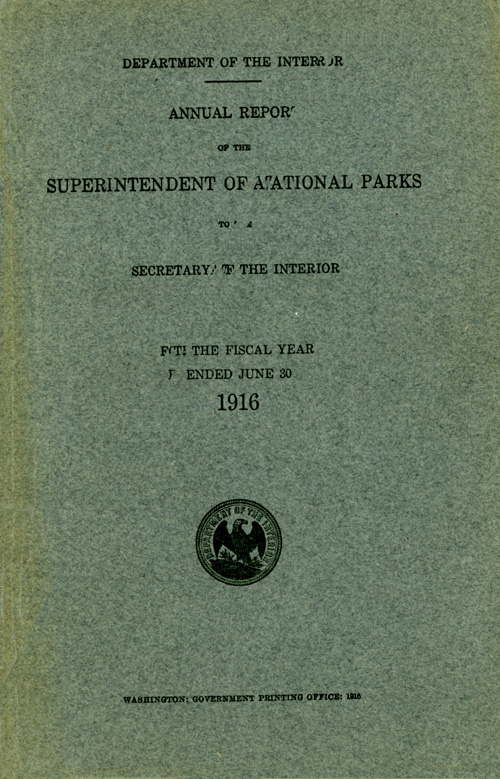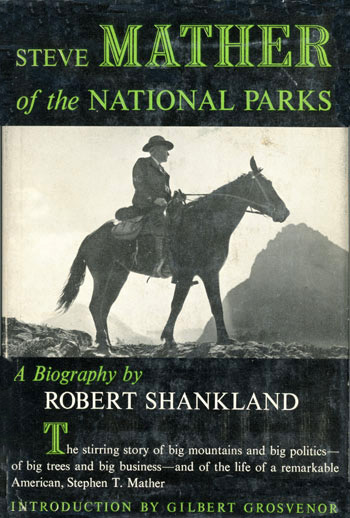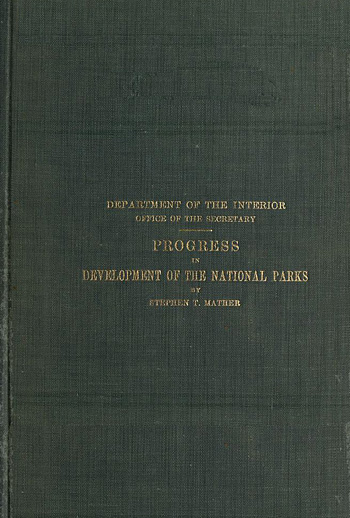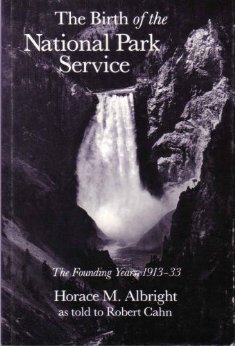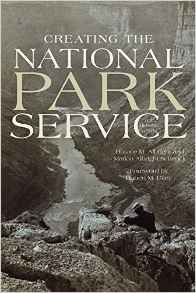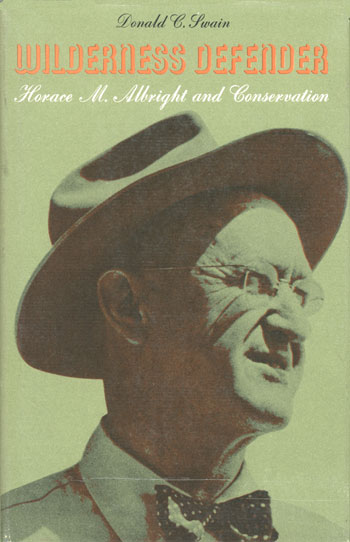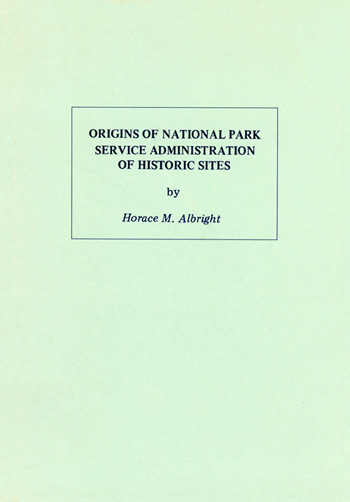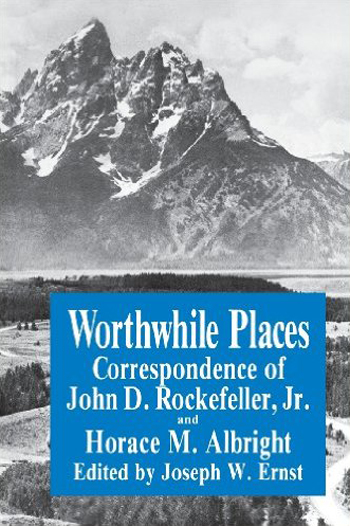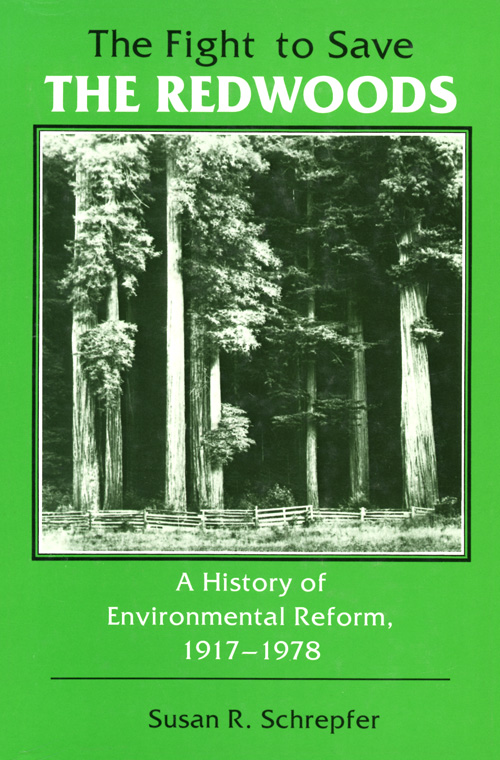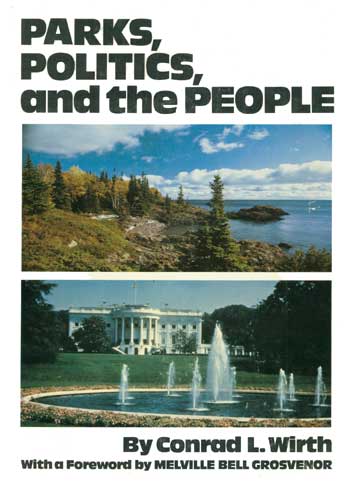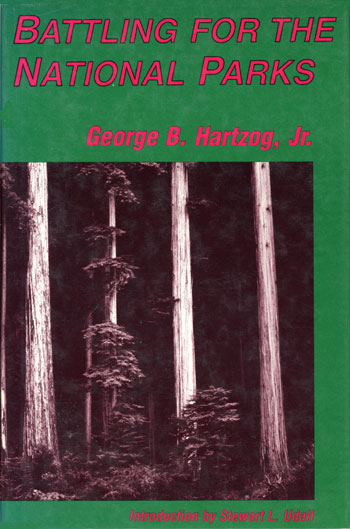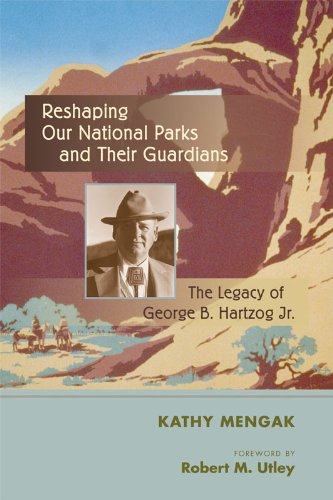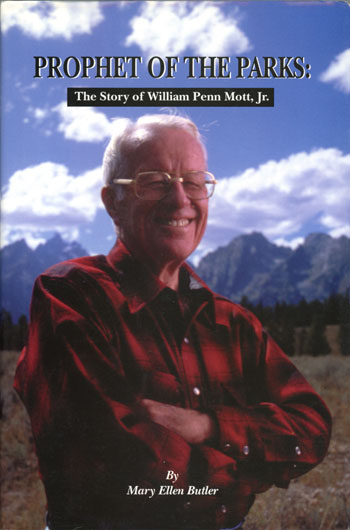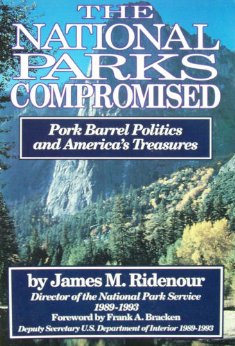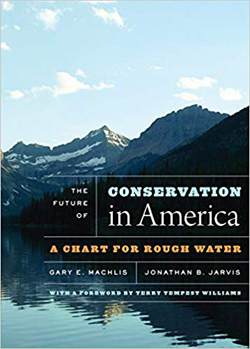
Directors of the National Park Service
 Stephen Tyng Mather and his staff in Washington, D.C., 1927 or 1928. From left to right, Arno B. Cammerer, Arthur E. Demaray, Stephen T. Mather, George A. Moskey and Horace M. Albright. (NPS Historic Photograph Collection HPC-000045 |
|
Prior to the establishment of the National Park Service on August 25, 1916 and the subsequent creation of its first Director, the following two individuals were selected by the Secretary of the Interior to manage national parks/monuments as the Superintendent of National Parks. To avoid confusion at that time, the title of those individuals who were entrusted in managing individual parks was changed to Supervisors (national parks) and Custodians (national monuments); during Director Mather's tenure, the title of park Superintendent was resumed (though Custodian was retained for those managing national monuments for another two decades). | ||||
Superintendents | ||||
| Mark Roy Daniels, 1913 - December 9, 1915 | ||||
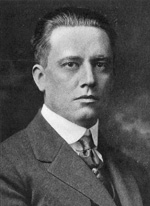
|
Mark Daniels was selected to become the first General Superintendent and Landscape Architect of national parks. Born in Spring Arbor, Michigan, Daniels received a landscape engineering degree at the University of California in 1905. In late 1913, at the urging of Professor Adolph C. Miller, assistant to the Secretary of the Interior (Franklin K. Lane) in charge of national parks, Secretary Lane promoted Daniels to become the general superintendent of parks, subsequently establishing his office in San Francisco. In late 1915, Daniels resigned his position and returned to his landscape architecture practice.
| |||
| Robert Bradford Marshall, December 10, 1915 - December 31, 1916 | ||||
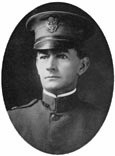
|
Robert B. (Bob) Marshall was born in Amelia County, Virginia in 1867 and started his career as a geographer with the U.S. Geological Survey, rising to the ranks of Chief Geographer in 1910. In 1915, at the urging of Stephen T. Mather, then assistant to the Secretary of the Interior Franklin K. Lane, Marshall was appointed to be the next (and last) Superintendent of National Parks, a position he held until 1917 when Director Mather became the first Director the newly established National Park Service. Bringing with him into this position was his secretary, Isabelle Story, as well as chief draftsman, Arthur Demaray, both of whom went on to become key players in National Park Service history. Marshall resumed the position of Chief Geographer in 1917 and went on to develop the Marshall Plan of irrigation and water control for Central Valley in California. He died in 1949. | |||
Directors | ||||
| Stephen Tyng Mather, May 16, 1917 - January 8, 1929 | ||||

|
A San Francisco native, Mather was a University of California graduate and a reporter for Dana's New York Sun. He entered the borax business, where he became a self-made millionaire and philanthropist. At 47, at the very pinnacle of success, he was on the lookout for new worlds to conquer. Stephen T. Mather came to Washington from Chicago in January 1915 as special assistant to Secretary of the Interior Franklin K. Lane for national park concerns. His vigorous efforts to build public and political support for the parks helped persuade Congress to create the National Park Service in 1916. Appointed the first NPS director in May 1917, he continued to promote park access, development, and use and contributed generously to the parks from his personal fortune. During his tenure the service's domain expanded eastward with the addition of Shenandoah, Great Smoky Mountains, and Mammoth Cave national parks. Periodically disabled by manic-depression, Mather left office in January 1929 after suffering a stroke and died a year later.
| |||
| Horace Marden Albright, January 12, 1929 - August 9, 1933 | ||||
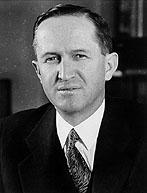
|
Also a graduate of the University of California, Albright earned a law degree and passed the bar in the State of California and the District of Columbia. Horace M. Albright came to the Interior Department from California in 1913 at the age of 23. After Mather's arrival Albright assisted him in overseeing the department's national parks and monuments and working for passage of the National Park Service legislation. Appointed NPS assistant director in May 1917, he acted as director for nearly two years while Mather was disabled by depression and launched the bureau's operations. From 1919 to 1929 he superintended Yellowstone National Park but continued to play a leading role in servicewide affairs. As Mather's successor in January 1929, he engineered the further expansion of an essentially western, natural park system to a truly national park system encompassing historic sites and memorials. He left to become vice president of U.S. Potash Co. in August 1933 after obtaining the sixty-two Agriculture and War departments' national monuments and military parks and the national capital parks, but he retained close ties to the NPS until his death in 1987.
| |||
| Arno Berthold Cammerer, August 10, 1933 - August 9, 1940 | ||||
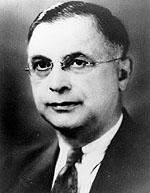
|
Arno B. Cammerer was born in Arapaho, Nebraska, went to Washington, D.C., in 1904 as a civil service bookkeeper and earned two degrees at Georgetown Law School. Mather spotted Cammerer's competence as executive secretary of the Fine Arts Commission and replaced Albright as assistant director in 1919, serving as Mather's right-hand man in Washington and acting for him in his frequent absences over the next decade. He advanced to the new rank of associate director in 1928, then succeeded Albright as director in August 1933. Under his leadership the NPS became involved with recreational area planning and management, supervised the Civilian Conservation Corps in both national and state parks, and began to survey and record historic sites and buildings outside the parks. Strained relations with Secretary of the Interior Harold L. Ickes impaired his effectiveness and health, and he stepped down after a heart attack in 1940 to become the service's eastern regional director. He died in that position the following year at the age of 57. | |||
| Newton Bishop Drury, August 20, 1940 - March 31, 1951 | ||||
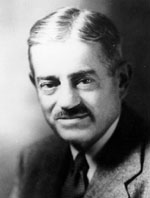
|
Newton B. Drury declined appointment as director in 1933 but accepted the job in 1940 at the age of 51. Drury had been a college classmate of Albright's and had served overseas in World War I. Born in Berkeley, he was the third Californian to lead NPS. He was the first director without prior national park responsibilities but came with strong conservationist credentials, having served for 20 years as executive secretary of the Save-the-Redwoods League in California. His term as Director was perhaps the most critical NPS has seen. During World War II he successfully resisted most demands for consumptive uses of park resources, turning back incessant demands to use the parks for mining, grazing, logging and farming under the guise of wartime or post-war necessity. Less eager than his predecessors to expand the park system, he opposed NPS involvement with areas he judged not to meet national park standards. Differences with Secretary of the Interior Oscar L. Chapman over Chapman's support for dams in Dinosaur National Monument contributed to Drury's resignation on April 1st, 1951. He was board chairman of the Save-the-Redwoods League when he died in 1978 at 88.
| |||
| Arthur Edward Demaray, April 1, 1951 - December 8, 1951 | ||||
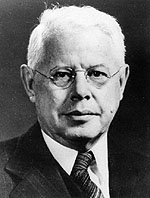
|
A Washington, D.C., native, Arthur E. Demaray entered the Government as a messenger at 16, and worked his way through night school. Formerly a draftsman with the U.S. Geological Survey, Demaray moved to the NPS when its headquarters was first staffed in 1917. His brief tenure (only 8 months) as NPS director in 1951 before his planned retirement was a reward for his long and distinguished service (34 years with NPS), the last 18 (starting in 1933) as Associate Director. In the second spot during the tumultuous New Deal and the difficult wartime years (when he remained in Washington while the headquarters office relocated to Chicago), he proved an extremely effective administrator. He testified effectively at Congressional and budget hearings and his writings stimulated park interest. Perhaps his greatest accomplishment was to maintain good working relations with Harold Ickes during the irascible secretary's 13-year regime (1933-46). Demaray retired Dec. 8, 1951 to live in Tucson, Ariz. He died in 1958 at 71. Suggested reading: Inventory of the Arthur E. Demaray papers, 1830-1979 | |||
| Conrad Louis Wirth, December 9, 1951 - January 7, 1964 | ||||
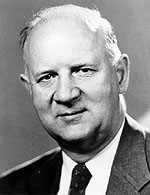
|
Conrad L. Wirth grew up in a park environment—his father was park superintendent for the city of Hartford, Conn., and later the city of Minneapolis. Wirth took a degree in landscape architecture from what is now the University of Massachusetts. He first came to the Washington, D.C., area to work for the National Capital Park and Planning Commission. Albright had him transferred into NPS in 1931, where he was put in charge of the Branch of Lands. With the coming of the New Deal he supervised the service's Civilian Conservation Corps program in the state parks. His administrative ability marked him to succeed Demaray, whom he served as associate director before advancing to the top job in December 1951 at the age of 52. Wirth's crowning achievement, he won President Eisenhower's approval for Mission 66, a 10-year, billion-dollar program to upgrade park facilities and services by the 50th anniversary of the NPS in 1966. After the 1961 change of administrations Wirth fell out of favor with Secretary of the Interior Stewart L. Udall and departed in early 1964. Wirth became a member of the National Geographic Society's Board of Trustees and remained active in conservation and Park Service alumni affairs. He died in 1993.
| |||
| George Benjamin Hartzog, Jr., January 9, 1964 - December 31, 1972 | ||||
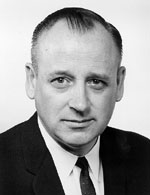
|
Remembered for his cream-colored Stetson, endless supply of elongated cigars and double-sized briefcase, Hartzog's irresistible energy and unorthodox bureaucratic style were captured in a New Yorker profile by John McPhee. George B. Hartzog, Jr., joined the NPS as an attorney in 1946, and took a science degree at American University in 1953. He moved to field assignments at Great Smoky Mountains and Rocky Mountains national parks, then made his name advancing the Gateway Arch project as superintendent of Jefferson National Expansion Memorial from 1959 to 1962, where he spearheaded the project for Eero Saarinen's Gateway Arch. After briefly leaving the service he returned as associate director in 1963 with the promise of succeeding Conrad Wirth in January 1964. A dynamic, politically astute manager, Hartzog welcomed some 70 new areas to the national park system during his nine-year tenure as director and greatly enlarged the service's role in urban recreation, historic preservation (following the passage of the Historic Preservation Act of 1966), the Bible amendment to the Alaska Native Claims Settlement Act that led to the establishment of the Alaska parks, interpretation, and environmental education. Closely identified with the expansionist policies of the Johnson-Udall administration, Hartzog was less appreciated by its successor and was dismissed in late 1972, and went on to practice law in Washington, D.C.. George Hartzog died in 2008.
| |||
| Ronald H. Walker, January 7, 1973 - January 3, 1975 | ||||
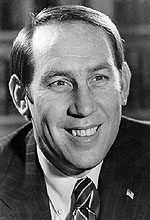
|
At 36, Ronald H. Walker was the youngest Director to hold the office and the second appointed from outside NPS. A soft-spoken and affable young man, he had been President Nixon's special assistant responsible for both domestic and international travel. Walker was born in Bryan, Tex., took a political science degree at the University of Arizona, served as an Army officer in Okinawa, and as an insurance and marketing executive. President Richard Nixon appointed Walker, an advance man on his staff, to replace George Hartzog in January 1973. Lacking park experience, Walker made Russell E. Dickenson, an NPS careerist, his deputy. Walker advocated a policy of "stabilization," foreseeing that NPS funding and staffing would be inadequate for a continuing high influx of new parks and program responsibilities. Fourteen areas nevertheless joined the park system during his two years as director, including the first two national preserves. As Director, he realigned NPS regional boundaries and added North Atlantic and Rocky Mountain offices. Under Walker, the early planning was done for the Servicewide American Revolution Bicentennial activities. Nixon's resignation in August 1974 presaged Walker's replacement five months later, where he became senior partner of Korn/Ferry International, later becoming the managing director for their Washington, D.C., offices. In 2009, Walker became president of the Richard Nixon Foundation, and a year later was promoted to Chairman of their Board of Directors. Suggested reading: Interview; Register of the Walker Papers, 1973-1974 | |||
| Gary E. Everhardt, January 13, 1975 - May 27, 1977 | ||||
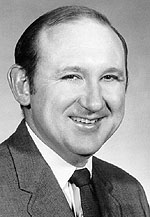
|
The ninth Director, Gary Everhardt was born in Lenoir, N.C., took a civil engineering degree at North Carolina State, served as an Army officer, and became an NPS engineer in 1957 and rose to the superintendency of Grand Teton National Park in 1972. Favorable notice there propelled him to the directorship in January 1975. As director he oversaw a great increase in park development and interpretive programming for the bicentennial of the American Revolution (NPS conducted activities at 250 sites coast-to-coast). Everhardt pushed wilderness designation and hailed a Presidential proposal for a $1.5 billion Bicentennial Land Heritage Program. During his Directorship, a policy council was created, which produced management objectives for the Service. Other firsts were the first national symposium on urban recreation; the first national conference on scientific research; the first Native crafts sales program in the parks; and the first international park publication, PARKS. The return of an NPS careerist to the job was much applauded by park employees and supporters, but Everhardt's leadership fell short of expectations, and the new Carter administration returned him to the field as Blue Ridge Parkway's superintendent in May 1977. Suggested reading: Gary Everhardt Papers, 1936-2005 | |||
| William Joseph Whalen, July 5, 1977 - May 13, 1980 | ||||
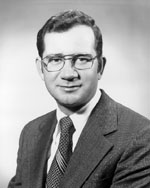
|
Again NPS ranks produced a Director. William J. Whalen had 12 years of varied NPS service before his Directorship. A native of Burgettstown, Pa., he joined NPS as a job corps counselor in 1965 and became well-known in Washington, D.C., as manager of the Summer in the Parks programs. Whalen advanced to posts in National Capital Parks and Yosemite National Park (deputy superintendent) before managing all NPS areas in the Bay Area of San Francisco, including Golden Gate National Recreation Area, in 1972. His experience in the burgeoning urban parks field contributed to his appointment as director in July 1977, yet the most significant event of his tenure was President Jimmy Carter's proclamation of much Alaska wilderness as national monuments in 1978, doubling the acreage under NPS jurisdiction. Management of an expanded System including vast new parks in Alaska challenged his best talents. Friction with park concessioners led to congressional calls for Whalen's removal in 1980, and Secretary of the Interior Cecil D. Andrus returned him to Golden Gate, as general superintendent of Golden Gate National Recreation Area. He left the NPS in 1983. Bill Wahlen died in 2006. Suggested reading: Interview | |||
| Russell Errett Dickenson, May 15, 1980 - March 3, 1985 | ||||
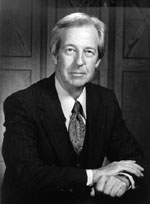
|
A Marine Corps veteran and graduate of Arizona State College, Russell E. Dickenson worked his way up through the NPS ranks. A native of Melissa, Tex., Dickenson began his NPS career as a ranger at Grand Canyon National Park in 1946 and served in a wide range of park and central office assignments — most prominently as chief, Division of Resource Management in the Midwest Region; in 1967, he transferred to WASO as chief of New Area Studies and Master Planning; served as Regional Director of the National Capital Region from 1969 to 1973; was the Deputy NPS Director from 1973 to 1975; and Pacific Northwest regional director for 4-1/2 years — before ascending to the directorship in May 1980. Having risen through the traditional ranks and enjoying the respect of his colleagues, Dickenson was enthusiastically welcomed to the job and supported in his effort to restore organizational stability after a succession of short-term directors. As when Walker's deputy, he preferred improving the service's stewardship of its existing parks to seeking new ones. The only Interior Department bureau chief to be retained by the Reagan administration in 1981, Dickenson obtained its support and that of Congress for the Park Restoration and Improvement Program, which devoted more than a billion dollars over five years to park resources and facilities. Dickenson has received numerous awards, including the Distinguished Service Award in 1972, for his work in urban park management. Dickenson retired in March 1985 and died in 2008. Suggested reading: Interview; Register of the Russell E. Dickenson Papers 1930-2008 | |||
| William Penn Mott, Jr., May 17, 1985 - April 16, 1989 | ||||
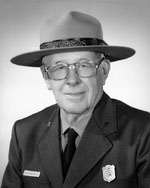
|
William Penn Mott, Jr., worked for the NPS as a landscape architect from 1933 to 1940 but devoted most of his later career to California's local and state parks. From 1946 to 1985 he served successively as Oakland's park superintendent, the East Bay Regional Park District's general manager, director of the State Department of Parks and Recreation under Governor Ronald Reagan, and general manager of the East Bay Zoological Society. Following his appointment as NPS director in May 1985, Mott issued a 12-point plan to protect the parks and their resources, better serve the public, and improve the service's management. He took a strong interest in park interpretation and returned the NPS to a more expansionist posture after a near-moratorium on park additions during President Reagan's first term. When the Bush administration replaced him with its own appointee in April 1989, Mott remained on the rolls as special assistant to the western regional director overseeing planning for the Presidio of San Francisco. He died in 1992 of pneumonia.
| |||
| James Michael Ridenour, April 17, 1989 - January 20, 1993 | ||||

|
James M. Ridenour was a Vietnam War veteran having served as a commander of a medical detachment. Ridenour served as director of the Indiana Department of Natural Resources for eight years before becoming NPS director in April 1989. Less willing than Mott to accept park system additions driven by local economic development interests, Ridenour spoke out against the "thinning of the blood" of the system and sought to retain the initiative from Congress in charting its expansion. He favored alternatives to full federal acquisition of proposed parklands, stressed the importance of working with other government bodies and private entities to protect lands in and outside the system, and sought to achieve a greater financial return to the NPS from park concessions. In 1991, Ridenour assembled a diverse group of park and public officials, public interest groups and individuals at Vail, Colorado, which developed a program known as the Vail Agenda, whose goal was establishment of a set of standards to guide NPS into the 21st century. He departed with the Bush administration in January 1993.
| |||
| Roger George Kennedy, June 1, 1993 - March 29, 1997 | ||||
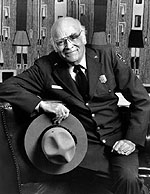
|
Roger G. Kennedy was a graduate of the University of Minnesota Law School and moved to Washington, D.C. in 1953 to work as a civil trial lawyer with the Department of Justice. Kennedy became a news correspondent before returning to his native Minnesota to serve as chairman/vice president for a number of financial institutions. The Clinton administration selected Roger G. Kennedy to head the NPS in 1993. He was especially concerned about expanding the service's educational role and moved to enlarge its presence beyond the parks via the Internet. During his tenure the NPS restructured its field operations and sharply reduced its central office staffs as part of a government-wide effort to downsize the federal bureaucracy. Kennedy resigned at the end of President Clinton's first term in 1997. He died from melanoma in 2011, at the age of 85. Suggested reading: Interview | |||
| Robert George Stanton, August 4, 1997 - January, 2001 | ||||
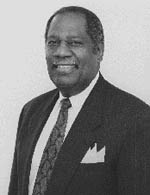
|
Beginning as a seasonal ranger at Grand Teton National Park in 1962, Robert (Bob) G. Stanton served the NPS as a ranger, superintendent, deputy regional director, assistant director, and regional director of the National Capital Region before retiring in January 1997. That August the Clinton administration restored him to active duty, making him the first NPS careerist since Dickenson to head the bureau. Also its first African American director, Stanton had taken particular interest in increasing the diversity of the service's staff and public programs to better serve minority populations. Suggested reading: Register of the Robert Stanton Papers 1962-2006 | |||
| Fran P. Mainella, July 18, 2001-October 16, 2006 | ||||
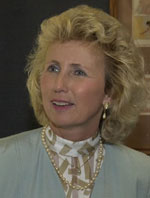
|
Fran P. Mainella is a Connecticut native, earning her bachelor's degree from the University of Connecticut and a master's degree from Central Connecticut State College. Mainella was nominated by President Bush on June 4, 2001 to the position of Director of the National Park Service. On July 18, 2001 Ms. Mainella became the 16th Director of the National Park Service and the first woman to head the 85-year-old agency. Mainella came to the National Park Service with more than 30 years of experience in the park management and recreation field, including 12 years as director of Florida's State Parks. Mainella is a visiting scholar at Clemson University. | |||
| Mary Amelia Bomar, October 17, 2006-January 20, 2009 | ||||
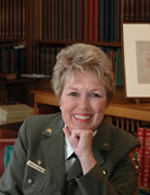
|
On October 17th, 2006, Mary A. Bomar was confirmed by the U.S. Senate and became the 17th Director of the National Park Service. Ms. Bomar is the first naturalized citizen to be the Director of the National Park Service. Previously, Bomar served as the Northeast Regional Director managing 100 parks in thirteen northeastern states. Bomar served as the Superintendent at Independence National Historical Park, was the first superintendent at the Oklahoma City National Memorial, the first NPS Oklahoma State Coordinator, acting superintendent at Rocky Mountain National Park and assistant superintendent at the San Antonio Missions National Historical Park. Bomar's National Park Service career began in the financial arena at Amistad National Recreation Area in Texas where she served as the Administrative Officer. | |||
| Jonathan B. Jarvis, October 2, 2009-January 3, 2017 | ||||
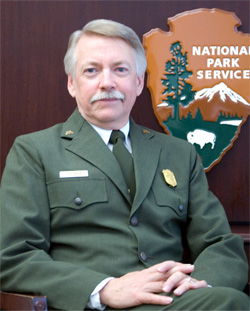
|
Jonathan (Jon) B. Jarvis was sworn in as the 18th director on Oct. 2, 2009, by Interior Secretary Ken Salazar. He began his National Park Service career as a seasonal interpretive ranger on the National Mall in 1976. Jarvis is a Virginia native and graduate of The College of William and Mary. Served as Pacific West Region Director 2002-09 where he was responsible for 54 national parks in Washington, Oregon, Idaho, California, Nevada, Hawaii and the Pacific Islands of Guam, Saipan and American Samoa and community revitalization programs that serve those states. He previously served as superintendent of Mount Rainier and Wrangell-St. Elias national parks, and Craters of the Moon National Monument. Other career positions: protection ranger, resource management specialist, park biologist, and chief of natural and cultural resources.
| |||
| Michael T. Reynolds, January, 3 2017-January 9, 2018 • Acting Director | ||||

|
Michael T. Reynolds (Mike) was designated the acting director of the National Park Service. Since August 1 2016, Reynolds served as the deputy director of Operations for the National Park Service (NPS). In this capacity, he was responsible for the day-to-day operations of the seven regions and the 413 parks nation-wide for the National Park Service, as well as program areas in Washington, DC. In April 2014, Reynolds was assigned to the National Park Service Headquarters in Washington, DC, as the associate director for Workforce, Relevancy, and Inclusion. Reynolds was appointed regional director of the Midwest Region in 2011. Prior to his appointment as the Midwest regional director, Reynolds served as deputy regional director of the Northeast Region in Philadelphia for four years. Earlier in his career, he was superintendent of Fire Island National Seashore, and his NPS career also includes stints as a resource manager, planner, and division chief at Yosemite National Park, Mojave National Preserve, Cape Cod National Seashore, Curecanti National Recreation Area, and the NPS Denver Service Center. | |||
| Paul Daniel Smith, January 9, 2018-September 30, 2019 • Deputy Director | ||||

|
Paul Daniel (Dan) Smith was appointed Deputy Director of the National Park Service. Smith served as superintendent of Colonial National Historical Park from 2004 to 2015. Smith's other assignments in the National Park Service include serving as Special Assistant to the National Park Service Director and Assistant Director of Legislative and Congressional Affairs. He also served as Deputy Assistant Secretary for Fish and Wildlife and Parks at the Department of the Interior. Smith also worked at the General Services Administration for ten years. In addition to Smith's Executive Branch experience held numerous important roles in the Legislative Branch as a staff member for a U.S. senator, a congressman, and two congressional committees. Smith was born in Maine. A Vietnam War veteran, Smith served in the U.S. Army's 4th Infantry. He received his Bachelor of Arts in Political Science and Master of Science in Recreation Administration from the University of North Carolina, Chapel Hill. | |||
| David Vela, October 1, 2019-August 7, 2020 • Deputy Director | ||||
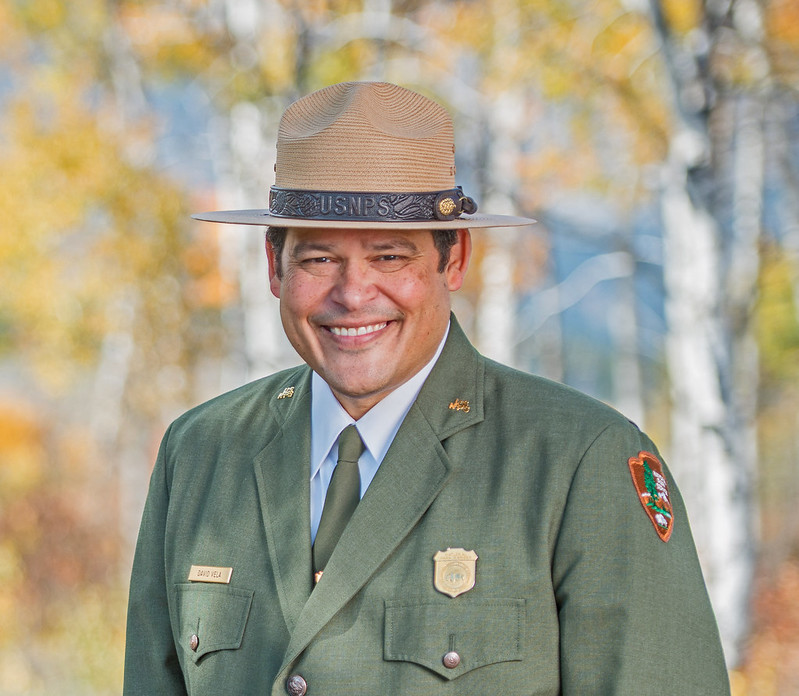
|
David Vela has served as the superintendent of Grand Teton National Park & the John D. Rockefeller, Jr. Memorial Parkway since 2014. He previously served as associate director for Workforce, Relevancy and Inclusion in the NPS Washington headquarters offices. He also served for over four years as the NPS Southeast Regional Director and as superintendent of Palo Alto Battlefield National Historic Site, Lyndon B. Johnson National Historical Park, and the George Washington Memorial Parkway. Since April 15, Vela has served as the NPS acting deputy director for operations. In the role of deputy director exercising the authority of the director, Vela will lead an agency with more than 20,000 employees, a nearly $3 billion budget, and 419 national parks. National parks attract more than 300 million visitors every year, generating over $30 billion in economic benefits across the nation. | |||
| Margaret Everson, August 7, 2020-January 20, 2021 • Counselor to the Secretary, exercising the delegated authority of the National Park Service Director | ||||
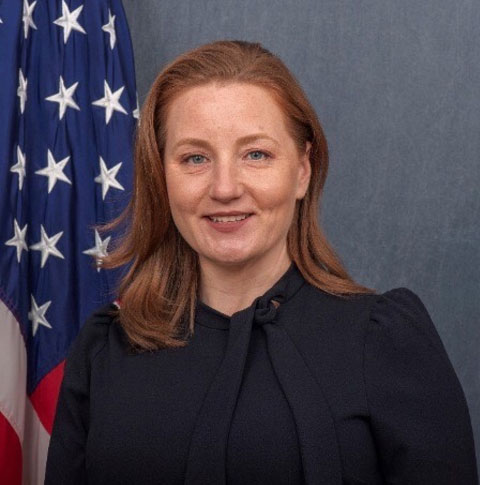
|
Margaret Everson served as Counselor to Secretary of Interior David L. Bernhardt supporting the NPS and U.S. Fish and Wildlife Service and Principle Deputy Director of the Fish and Wildlife Service. Prior to rejoining the Fish and Wildlife Service, she worked as Ducks Unlimited's Chief Policy Officer for four years. Everson served in a variety of roles that touched wildlife, conservation and natural resources matters. Prior to joining Ducks Unlimited, she worked as a consultant for state agencies, as well as an assistant attorney general of Kentucky and general counsel for the Kentucky Department of Fish and Wildlife Resources. From 2006 to 2008, Everson was appointed by the Secretary of the Interior to serve as counselor to Dale Hall, then Director of the Service. Prior to joining the Service, she was with the Department of the Interior's Solicitor's office for four years and the former chair of the American Wildlife Conservation Partners. Everson received her Bachelor of Science in biology with a concentration in marine biology from St. Francis College and her Juris Doctorate from Vermont Law School. | |||
| Shawn Benge, August 31, 2020-November 18, 2021 • Deputy Director | ||||
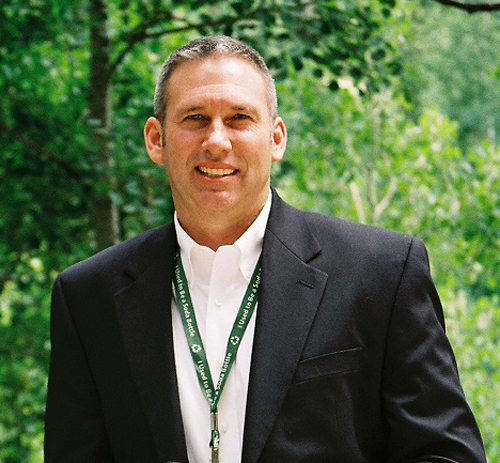
|
Shawn Benge served as the acting deputy director for operations starting in October 2019, is responsible for the day-to-day operations of the NPS. Before his current assignment, Shawn served as the associate director for the Park Planning, Facilities, and Lands (PPFL) Directorate. In his role overseeing PPFL, he provided leadership, policy development, program accountability, and budget formulation in the functional areas of park planning and development; special resource studies; land acquisition and related real estate operations; facility and infrastructure design, construction, and maintenance. Prior to coming to Washington in 2016, Benge served as the deputy regional director/chief of staff for Interior's Region 2. In addition, Benge led the regional program areas of visitor and resource protection, facilities management, interpretation and education, and communications. He served as a primary bureau official responsible for managing NPS oil spill response activities associated with Deepwater Horizon. Benge served in numerous capacities at the park level—including superintendent assignments—at Big Bend National Park, Great Smoky Mountains National Park, Chickamauga and Chattanooga National Military Park, and Everglades National Park and a tour at the Denver Service Center, the NPS's central planning and design office. | |||
| Charles F. "Chuck" Sams III, November 18, 2021-January 20, 2025 • Director | ||||
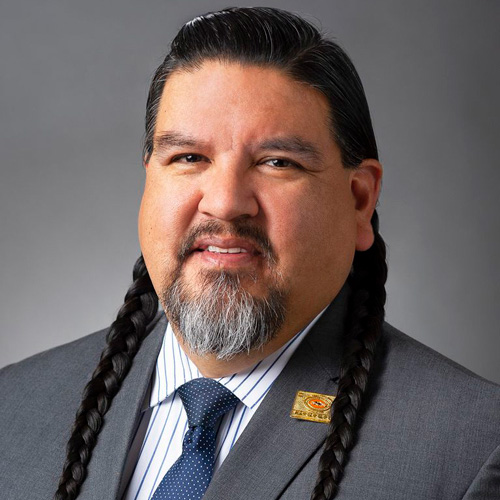
|
Chuck Sams worked in State and Tribal governments and the non-profit natural resource and conservation management fields for more than 25 years, serving as a Council Member to the Northwest Power and Conservation Council, appointed by Oregon Governor Kate Brown. He has held a variety of roles with the Confederated Tribes of the Umatilla Indian Reservation, including their Executive Director. He has also had roles as the President/Chief Executive Officer of the Indian Country Conservancy, Executive Director for the Umatilla Tribal Community Foundation, National Director of the Tribal & Native Lands Program for the Trust for Public Land, Executive Director for the Columbia Slough Watershed Council, Executive Director for the Community Energy Project, and President/Chief Executive Officer for the Earth Conservation Corps. Chuck holds a bachelor's of science degree in Business Administration from Concordia University-Portland and a master's of legal studies in Indigenous Peoples Law from the University of Oklahoma. He is a veteran of the U.S. Navy. Chuck is an enrolled member, Cayuse and Walla Walla, of the Confederated Tribes of the Umatilla Indian Reservation, where he lives with his wife and their four children. | |||
| Jessica Bowron, January 20, 2025-present • Acting Director | ||||

|
Jessica Bowron served as the Comptroller of the National Park Service. In this role, she oversaw the budget, finance and related functions of the agency. She worked in various budget functions for the National Park Service since 2007, when she joined Federal service through the Presidential Management Fellowship. She previously served as the Chief of NPS Budget Formulation and Strategic Planning and as the Budget Execution Lead for the NPS Fire and Aviation Program. Jessica holds a Bachelor of Science from Oregon State University and a Master of Science in Natural Resource Economics from the University of Arizona. | |||
Additional insights into the history of the National Park Service can be gleaned from the writings of the Secretaries of the Interior (prior to the establishment of the National Park Service) and the NPS Directors in their Annual Reports.
Annual Reports of the Department of the Interior
(Ethan A. Hitchcock, 1899-1907 — James R. Garfield, 1907-1909 — Richard A. Ballinger, 1909-1911 — Walter L. Fisher, 1911-1913 — Franklin K. Lane, 1913-1920)
1904 •
1905 •
1906 •
1907 •
1908 •
1909 •
1910 •
1911 •
1912 •
1913 •
1914 •
1915 •
1916
Annual report of the superintendent of national parks to the secretary of the interior for the fiscal year ended June 30, 1916 (R.B. Marshall, 1916)
Progress in the Development of the National Parks (Stephen Mather, 1916)
Directors' Annual Reports
1917 •
1918 •
1919 •
1920 •
1921 •
1922 •
1923 •
1924 •
1925 •
1926 •
1927 •
1928 •
1929 •
1929-1932 •
1942-1943 •
1946-1950 •
1952-1954 •
1955 •
1958-1963
(Portions of the above biographies were taken from 65th Anniversary National Park Service)
Date: 22-Jan-2025
